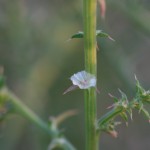Russian Thistle, Tumbleweed
Salsola iberica
Chenopodiaceae
Description
Tumbleweed is a manybranched, annual herb growing to 2 to 6 feet tall. At maturity, the plant is stiff, prickly, round and bushy. The spine-tipped leaves are oval. The stems have distinctive dark purplish striations (parallel to the stem) when the plant is young and growing. Tumbleweed is a member of the goosefoot family.
Habitat
Tumbleweed is found in every region of Texas except the Piney Woods and Post Oak Savannah. It is most abundant along roads, in irrigated fields and in disturbed areas.
Toxic Agent
Nitrate is the toxic agent. All ruminants are susceptible to nitrate poisoning, with cattle poisoned most often. Plants with more than 1.0 percent nitrate are dangerous; animals may die if they have consumed as little as 0.075 percent of their weight in nitrate. Environmental factors often influence nitrate. For example, nitrate poisoning is more likely if the plant grows in soils high in nitrogen, such as in livestock pens or fertilized areas. Excessive shade, lack of water, and stress or physical damage may also increase nitrate levels.
Signs of Livestock Ingestion
Animals with acute nitrate poisoning are often found dead with no previous history of illness. Less acute nitrate poisoning signs occur in this order: Weakness; Unsteady gait; Collapse; Shallow and rapid breathing; Rapid pulse; Dilated pupils; Recovery; Delayed abortion; Coma; Sudden death.
Unpigmented parts of the body such as the whites of the eye, the tongue and lips may have a bluebrown discoloration; the blood may be a chocolate brown color.
Management Strategies
Avoid areas infested with this plant during drought, after a period of extended cool, cloudy weather, or after a heavy application of nitrogen fertilizer. Rations high in carbohydrates also help reduce losses from nitrate poisoning. Keep poisoned animals quiet, and administer methylene blue intravenously. Generally, use a 1 to 4 percent solution containing 5 percent dextrose at a rate of 1 gram of methylene blue per 250 pounds of animal weight. Be certain of the diagnosis of nitrate poisoning before treating with methylene blue.
Images
Plant Characteristics
Seed Type: Fruit/Berry
Duration: Annual
Stem Texture: Hairless/Smooth, Prickly, Spiny, or Thorny
Growth Habit: Forbs/Broadleaf
Leaf Shape
 : Simple with Pinnate or Parallel Venation
: Simple with Pinnate or Parallel Venation
Season: Warm
Distribution
 : 02 - Gulf Prairies and Marshes, 04 - Blackland Prairies, 05 - Cross Timbers and Prairies, 06 - South Texas Plains, 07 - Edwards Plateau, 08 - Rolling Plains, 09 - High Plains, 10 - Trans-Pecos
: 02 - Gulf Prairies and Marshes, 04 - Blackland Prairies, 05 - Cross Timbers and Prairies, 06 - South Texas Plains, 07 - Edwards Plateau, 08 - Rolling Plains, 09 - High Plains, 10 - Trans-Pecos
Distributions
Distribution refers to the ecological region in Texas that a plant has been found. You can also view a clickable map.
Book: Toxic Plants of Texas (B-6105)
Collection: Toxics
Livestock Affected: Cattle, Goats, Horses, Sheep
Livestock Signs: Abnormal Heartbeat, Abortion, Collapse, Coma, Convulsions, Depression/ Weakness, Dilated Pupils, Incoordination, Irregular Breathing, Sudden Death





